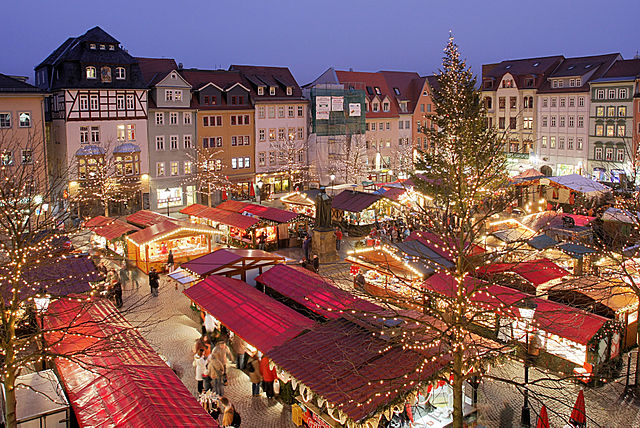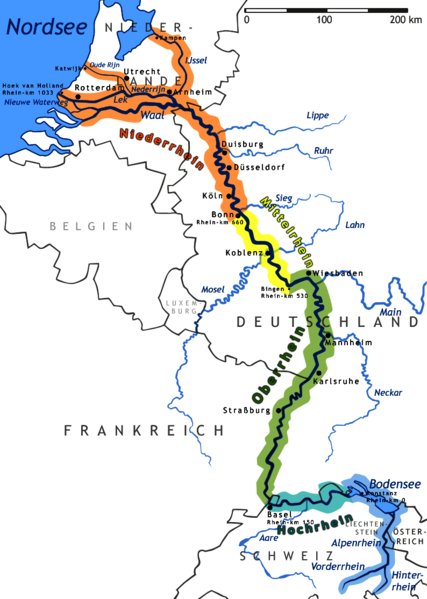Karte Gemeinde Guggisberg 2007. [Map of Municipality Guggisberg.] By Tschubby (Own work) [GFDL (http://www.gnu.org/copyleft/fdl.html), CC-BY-SA-3.0 (http://creativecommons.org/licenses/by-sa/3.0/) or CC BY-SA 2.5-2.0-1.0 (http://creativecommons.org/licenses/by-sa/2.5-2.0-1.0)]. Available from Wikimedia Commons.
This map shows the location of Guggisberg in Canton Bern, Switzerland. My 3rd-great-grandfather Davidson Binkley is believed to be a descendant of Peter Binkley (also Binggeli and Binckele). Peter was born in Guggisberg in 1704.
Covering genealogy, family history, historical events and places, and anything else related!
Showing posts with label Switzerland. Show all posts
Showing posts with label Switzerland. Show all posts
Monday, August 10, 2015
Monday, December 22, 2014
German Christmas Traditions
Weihnachtsmarkt (Christmas market) in Jena, Thuringia, Germany. 21 December 2007. Photo by Rene Schwietzke [CC BY-SA 2.0 (http://creativecommons.org/licenses/by-sa/2.0)]. Available at Flickr and Wikimedia Commons.
Christmas Day is known as Weihnachten in Germany and other German-speaking countries such as Austria and Switzerland. Many of our traditional Christmas customs originated in Germany and Austria.
The Christmas tree (Tannenbaum) originated in Germany in the Middle Ages. The first Christmas trees were decorated with fruits and nuts.
After the Protestant Reformation, Martin Luther established the tradition of the Christkind (Christ child) as the bringer of Christmas gifts, to discourage the giving of gifts at St. Nicholas' Day (December 6). Christmas Eve became the day for gift-giving. German children receive gifts from either the Christkind or the Weihnachtsmann (Christmas man, the German Santa Claus), depending on the region in which they live.
Christmas markets originated in Germany and Austria during the Middle Ages. These street markets would be open during the four weeks of Advent. Attractions at the markets include a Nativity scene and nutcrackers. Christmas ornaments, decorations, toys, handmade items, and food are sold.
The Christmas carol "Silent Night" originated in Austria. "Stille Nacht" was written in 1818. Joseph Mohr, a Catholic priest, had written a poem two years earlier, and he wanted it set to music so he could use it as a carol at Midnight Mass. His friend Franz Xaver Gruber wrote the music on 24 December 1818, in just a few hours.
References
Christmas customs and recipes
Christmas market
Christmas Traditions in Germany, Austria, Switzerland
Christkind
German Christmas traditions
The German Christmas Tree
Stille Nacht - Silent Night
A Symbol for Nuremberg: The Origin of the Christkind
Weihnachten
Christmas Day is known as Weihnachten in Germany and other German-speaking countries such as Austria and Switzerland. Many of our traditional Christmas customs originated in Germany and Austria.
The Christmas tree (Tannenbaum) originated in Germany in the Middle Ages. The first Christmas trees were decorated with fruits and nuts.
After the Protestant Reformation, Martin Luther established the tradition of the Christkind (Christ child) as the bringer of Christmas gifts, to discourage the giving of gifts at St. Nicholas' Day (December 6). Christmas Eve became the day for gift-giving. German children receive gifts from either the Christkind or the Weihnachtsmann (Christmas man, the German Santa Claus), depending on the region in which they live.
Christmas markets originated in Germany and Austria during the Middle Ages. These street markets would be open during the four weeks of Advent. Attractions at the markets include a Nativity scene and nutcrackers. Christmas ornaments, decorations, toys, handmade items, and food are sold.
The Christmas carol "Silent Night" originated in Austria. "Stille Nacht" was written in 1818. Joseph Mohr, a Catholic priest, had written a poem two years earlier, and he wanted it set to music so he could use it as a carol at Midnight Mass. His friend Franz Xaver Gruber wrote the music on 24 December 1818, in just a few hours.
References
Christmas customs and recipes
Christmas market
Christmas Traditions in Germany, Austria, Switzerland
Christkind
German Christmas traditions
The German Christmas Tree
Stille Nacht - Silent Night
A Symbol for Nuremberg: The Origin of the Christkind
Weihnachten
Monday, August 11, 2014
Mappy Monday: Rhine River (Fluss Rhein)
Rhein-Karte. Map by Daniel Ullrich (Threedots) [CC-BY-SA-3.0 (http://creativecommons.org/licenses/by-sa/3.0)]. Available from Wikimedia Commons.
This map shows the Rhine River (Fluss Rhein). The Vorderrhein and Hinterrhein come together in Switzerland. The Hochrhein (High Rhine) flows to the west from Lake Constance to Basel, Switzerland. The Oberrhein (Upper Rhine) flows from Basel to Bingen, Germany. This section of the Rhine flows through Switzerland, France (Alsace), and the German states of Baden-Württemburg, Rhineland-Palatinate (Rheinland-Pfalz), and Hesse. The Mittelrhein (Middle Rhine) flows from Bingen to Bonn. The Niederrhein (Lower Rhine) begins in Bonn. After it enters the Netherlands, it splits into branches, including Waal, Merwede, Nieuwe Maas, and Nederrijn, and flows out to the North Sea.
My German ancestors lived by the Rhine River. My Schneider ancestors were from Erpel and Remagen. My Nagel ancestors lived in Bonn for a while. They were originally from Hürth (Hermülheim, Kendenich), which is near the Rhine. My Gersbacher/Gerspacher ancestors were from the Hotzenwald region in Baden, in Görwihl and Niederwihl (now part of Görwihl). My Dreier ancestors were from Niederwihl. Görwihl is at the edge of the river Alb, which is a tributary of the Rhine.
This map shows the Rhine River (Fluss Rhein). The Vorderrhein and Hinterrhein come together in Switzerland. The Hochrhein (High Rhine) flows to the west from Lake Constance to Basel, Switzerland. The Oberrhein (Upper Rhine) flows from Basel to Bingen, Germany. This section of the Rhine flows through Switzerland, France (Alsace), and the German states of Baden-Württemburg, Rhineland-Palatinate (Rheinland-Pfalz), and Hesse. The Mittelrhein (Middle Rhine) flows from Bingen to Bonn. The Niederrhein (Lower Rhine) begins in Bonn. After it enters the Netherlands, it splits into branches, including Waal, Merwede, Nieuwe Maas, and Nederrijn, and flows out to the North Sea.
My German ancestors lived by the Rhine River. My Schneider ancestors were from Erpel and Remagen. My Nagel ancestors lived in Bonn for a while. They were originally from Hürth (Hermülheim, Kendenich), which is near the Rhine. My Gersbacher/Gerspacher ancestors were from the Hotzenwald region in Baden, in Görwihl and Niederwihl (now part of Görwihl). My Dreier ancestors were from Niederwihl. Görwihl is at the edge of the river Alb, which is a tributary of the Rhine.
Labels:
Baden,
Dreier,
Erpel,
France,
Germany,
Gersbacher,
Gerspacher,
Görwihl,
Hermülheim,
Hürth,
Kendenich,
Mappy Monday,
Nagel,
Netherlands,
Niederwihl,
Remagen,
Rhine,
Schneider,
Switzerland
Friday, August 1, 2014
Swiss National Day
Flag of Switzerland. Photo by Wladyslaw (Own work) [GFDL (http://www.gnu.org/copyleft/fdl.html) or CC-BY-SA-3.0 (http://creativecommons.org/licenses/by-sa/3.0/)]. Available from Wikimedia Commons.
August 1 is Swiss National Day. The first celebration was in 1891, commemorating the 600th anniversary of the Swiss Confederation. In early August 1291, the cantons of Uri, Schwyz, and Unterwalden signed the Federal Charter of 1291. The day did not officially become a national holiday until 1994, after a vote on 26 September 1993.
The day is celebrated with fireworks, bonfires, and parades. At the Rhine Falls near Schaffhausen, there is a "Fire on the Rocks" fireworks display (which takes place the night before, July 31). The falls are illuminated during the display. A festival is held on the Rhine (also on July 31) at Basel. It includes fireworks, taverns and stalls, and musical performances. The celebration at Rütli includes a reading of the Rütlischwur, the oath of alliance which was taken at Rütli. In Zürich, a procession and festival are held.
Celebrations are also held outside Switzerland, in locations including New York City, Washington, D.C., Whittier, California, and Sutton, Quebec, Canada (in the town of Sutton and at the Mont SUTTON ski resort).
My 3rd-great-grandfather Davidson Binkley is believed to be a descendant of Peter Binkley (also Binggeli and Binckele), who was born in Guggisberg, Canton Bern, Switzerland on 2 March 1704 and came to Pennsylvania in 1736.
Fireworks in Basel at the Swiss national day. Photo by Vincent de Groot (Own work) [CC-BY-SA-3.0 (http://creativecommons.org/licenses/by-sa/3.0)]. Available from Wikimedia Commons.
Paper lanterns, Reinach. Photo by Roland Zumbühl (Picswiss), Arlesheim (Commons: Picswiss project) [GFDL (http://www.gnu.org/copyleft/fdl.html) or CC-BY-SA-3.0 (http://creativecommons.org/licenses/by-sa/3.0/)]. Available from Wikimedia Commons.
References
Celebrating Swiss National Day, 1 August
Swiss National Day
Swiss National Day, August 1st
About the SND NYC
August 1 is Swiss National Day. The first celebration was in 1891, commemorating the 600th anniversary of the Swiss Confederation. In early August 1291, the cantons of Uri, Schwyz, and Unterwalden signed the Federal Charter of 1291. The day did not officially become a national holiday until 1994, after a vote on 26 September 1993.
The day is celebrated with fireworks, bonfires, and parades. At the Rhine Falls near Schaffhausen, there is a "Fire on the Rocks" fireworks display (which takes place the night before, July 31). The falls are illuminated during the display. A festival is held on the Rhine (also on July 31) at Basel. It includes fireworks, taverns and stalls, and musical performances. The celebration at Rütli includes a reading of the Rütlischwur, the oath of alliance which was taken at Rütli. In Zürich, a procession and festival are held.
Celebrations are also held outside Switzerland, in locations including New York City, Washington, D.C., Whittier, California, and Sutton, Quebec, Canada (in the town of Sutton and at the Mont SUTTON ski resort).
My 3rd-great-grandfather Davidson Binkley is believed to be a descendant of Peter Binkley (also Binggeli and Binckele), who was born in Guggisberg, Canton Bern, Switzerland on 2 March 1704 and came to Pennsylvania in 1736.
Rhine Falls fireworks. Photo by SISHION (Own work) [CC-BY-SA-3.0 (http://creativecommons.org/licenses/by-sa/3.0)]. Available from Wikimedia Commons.
Fireworks in Basel at the Swiss national day. Photo by Vincent de Groot (Own work) [CC-BY-SA-3.0 (http://creativecommons.org/licenses/by-sa/3.0)]. Available from Wikimedia Commons.
Bonfire, Reinach. Photo by Roland Zumbühl (Picswiss), Arlesheim (Commons: Picswiss project) [GFDL (http://www.gnu.org/copyleft/fdl.html) or CC-BY-SA-3.0 (http://creativecommons.org/licenses/by-sa/3.0/)]. Available from Wikimedia Commons.
Paper lanterns, Reinach. Photo by Roland Zumbühl (Picswiss), Arlesheim (Commons: Picswiss project) [GFDL (http://www.gnu.org/copyleft/fdl.html) or CC-BY-SA-3.0 (http://creativecommons.org/licenses/by-sa/3.0/)]. Available from Wikimedia Commons.
References
Celebrating Swiss National Day, 1 August
Swiss National Day
Swiss National Day, August 1st
About the SND NYC
Subscribe to:
Posts (Atom)








